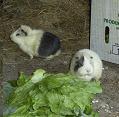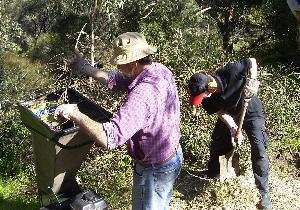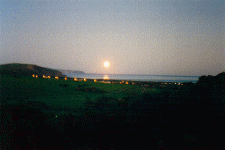|
 Home Home
 What's New? What's New?
 Definition Definition
 Our Design Our Design
 Techniques Techniques
 Articles Articles
 Blog Blog
 About Us About Us
 Year Planner Year Planner
 Resources Resources
 Links Links

Like us on
FaceBook!

Link to this site
|
|
Making Our Own Mulch
Copyright © Beverley Paine October, 2007
Our mulcher is a Masport 6.5HP.
 We've done some maintenance on the machine in the last year. My dad, although in his seventies, doesn't know his own strength and is a workaholic and pushed some thick dead wood through the side shoot and broke the weld. We purchased suitable parts and my sons repaired the mulcher. We've also replaced and sharpened blades. It had done a fair bit of work before then, but like most machines works best if kept well maintained. We're not so good at doing the cleaning and checking over after use - it's the only way to make sure your investment will serve you well for years. We've done some maintenance on the machine in the last year. My dad, although in his seventies, doesn't know his own strength and is a workaholic and pushed some thick dead wood through the side shoot and broke the weld. We purchased suitable parts and my sons repaired the mulcher. We've also replaced and sharpened blades. It had done a fair bit of work before then, but like most machines works best if kept well maintained. We're not so good at doing the cleaning and checking over after use - it's the only way to make sure your investment will serve you well for years.
 It's noisy so you really need to use those ear defenders. Safety glasses are a must too as the chips that fly out hurt. It's noisy so you really need to use those ear defenders. Safety glasses are a must too as the chips that fly out hurt.
Best not to mulch dead wood as it's really hard and does a lot of damage if a chip hits you. We generally only mulch prunings, but not vines or climbers unless the pieces are cut into lengths less than a metre.
It's really important to obey all the information that comes with the mulcher - eg not to put too wide diameter purnings in the side shoot. The damage our machine has sustained was caused by us, not any defect in the mulcher design or manufacture.
 It's a high unit and I find I have to stretch to put prunings in the shute, but the guys have no problem. We generally cut a huge pile of prunings (equivalent at least to a 6x4 trailer piled high) and then set about mulching. Two hours of pruning and mulching is enough for one day! Depending on the natuer of the plants you are mulching the mulch usually lasts a year. Leafy material makes a great fine mulch that composts quickly, so if you use it you need to add manure or fertiliser to stop it robbing the soil beneath of nitrogen. We also use the mulch in place of straw in the animal enclosures - this is then put onto the vegie garden without further composting. It's a high unit and I find I have to stretch to put prunings in the shute, but the guys have no problem. We generally cut a huge pile of prunings (equivalent at least to a 6x4 trailer piled high) and then set about mulching. Two hours of pruning and mulching is enough for one day! Depending on the natuer of the plants you are mulching the mulch usually lasts a year. Leafy material makes a great fine mulch that composts quickly, so if you use it you need to add manure or fertiliser to stop it robbing the soil beneath of nitrogen. We also use the mulch in place of straw in the animal enclosures - this is then put onto the vegie garden without further composting.
Mulching is an activity that can done at any time of the year, with the exception of Total Fire Ban Days, as using machinery of this type is banned, and you'd be a bit of nut to want to work on a day like that anyway! We tend to mulch when we need mulch, or when we need to prune. Up until recently we've been steadily working our way through the many feral olive trees on our property. We are leaving a dozen or so of these to continue growing so that we can regulary coppice them as an on-going source of mulch for our garden beds.
We've found that our garden produces copious quantities of materials to mulch each year. The bonus of mulching our own material is that we're keeping the understorey tidy and this reduces the risk of wild fire totally destroying everything.
|
|

Our ever-changing view!
Moonset ~ Roll Cloud ~ Sunset
|
permaculture ethics |
care for earth,
care for people,
return surplus,
reduce consumption |
 |
|
Recently Added Pages
Hot Links!

Bookworm is currently reading...
This site is sponsored by
ALWAYS LEARNING BOOKS
Publishers of Australian
books on Home Education.
  The Educating Parent The Educating Parent
  Beverley's other websites Beverley's other websites
|


 We've done some maintenance on the machine in the last year. My dad, although in his seventies, doesn't know his own strength and is a workaholic and pushed some thick dead wood through the side shoot and broke the weld. We purchased suitable parts and my sons repaired the mulcher. We've also replaced and sharpened blades. It had done a fair bit of work before then, but like most machines works best if kept well maintained. We're not so good at doing the cleaning and checking over after use - it's the only way to make sure your investment will serve you well for years.
We've done some maintenance on the machine in the last year. My dad, although in his seventies, doesn't know his own strength and is a workaholic and pushed some thick dead wood through the side shoot and broke the weld. We purchased suitable parts and my sons repaired the mulcher. We've also replaced and sharpened blades. It had done a fair bit of work before then, but like most machines works best if kept well maintained. We're not so good at doing the cleaning and checking over after use - it's the only way to make sure your investment will serve you well for years.  It's noisy so you really need to use those ear defenders. Safety glasses are a must too as the chips that fly out hurt.
It's noisy so you really need to use those ear defenders. Safety glasses are a must too as the chips that fly out hurt.  It's a high unit and I find I have to stretch to put prunings in the shute, but the guys have no problem. We generally cut a huge pile of prunings (equivalent at least to a 6x4 trailer piled high) and then set about mulching. Two hours of pruning and mulching is enough for one day! Depending on the natuer of the plants you are mulching the mulch usually lasts a year. Leafy material makes a great fine mulch that composts quickly, so if you use it you need to add manure or fertiliser to stop it robbing the soil beneath of nitrogen. We also use the mulch in place of straw in the animal enclosures - this is then put onto the vegie garden without further composting.
It's a high unit and I find I have to stretch to put prunings in the shute, but the guys have no problem. We generally cut a huge pile of prunings (equivalent at least to a 6x4 trailer piled high) and then set about mulching. Two hours of pruning and mulching is enough for one day! Depending on the natuer of the plants you are mulching the mulch usually lasts a year. Leafy material makes a great fine mulch that composts quickly, so if you use it you need to add manure or fertiliser to stop it robbing the soil beneath of nitrogen. We also use the mulch in place of straw in the animal enclosures - this is then put onto the vegie garden without further composting.


